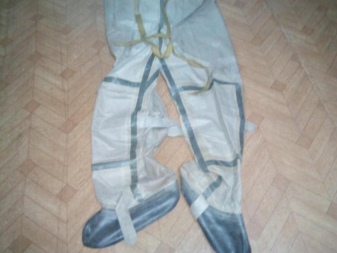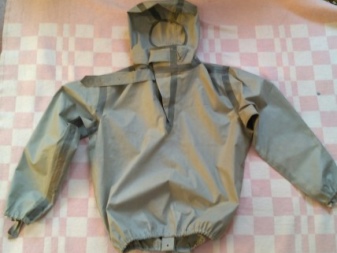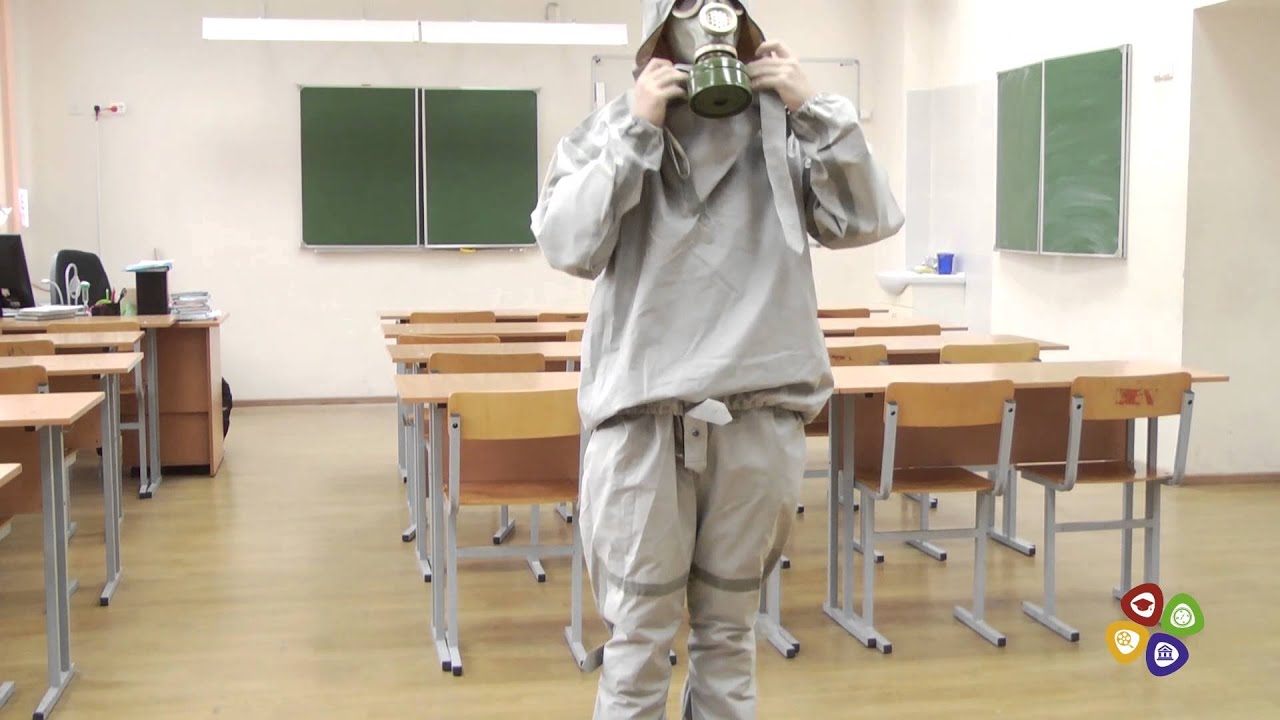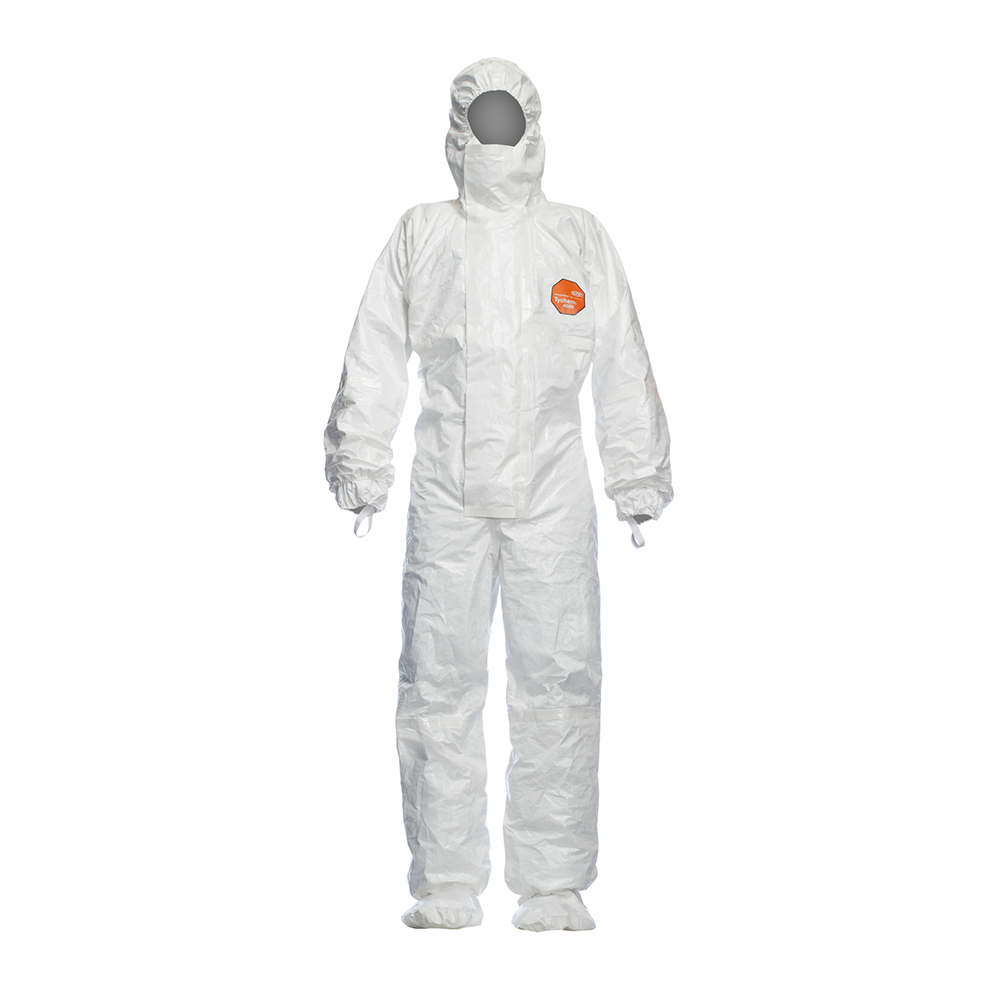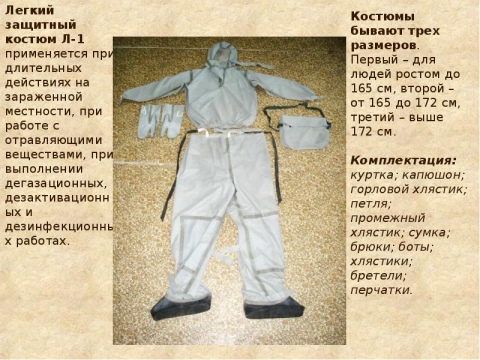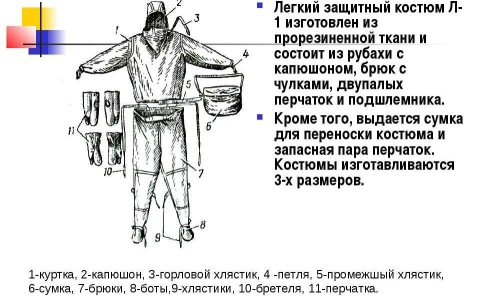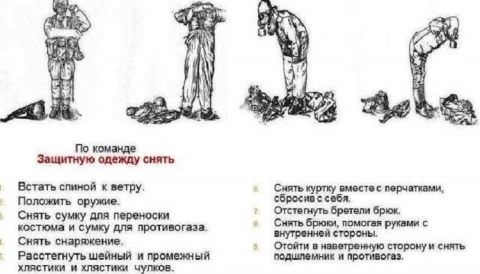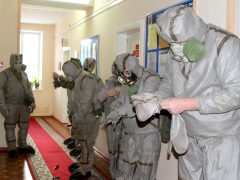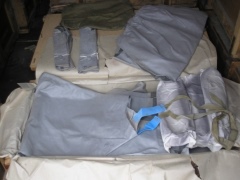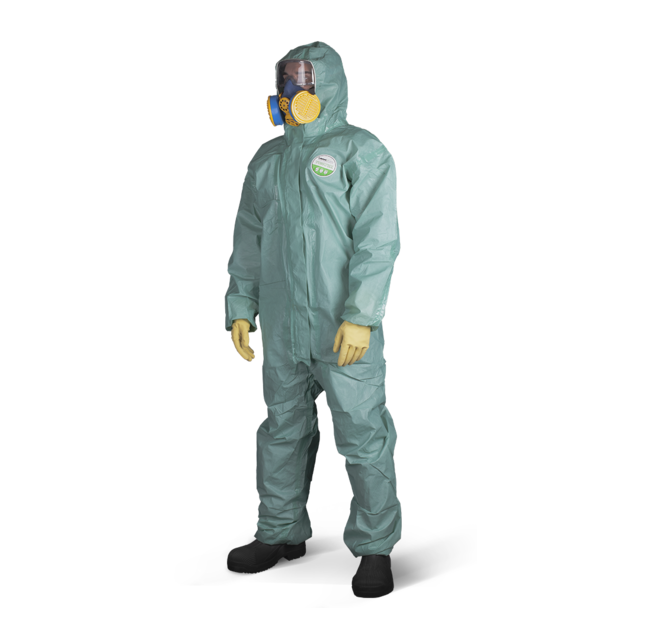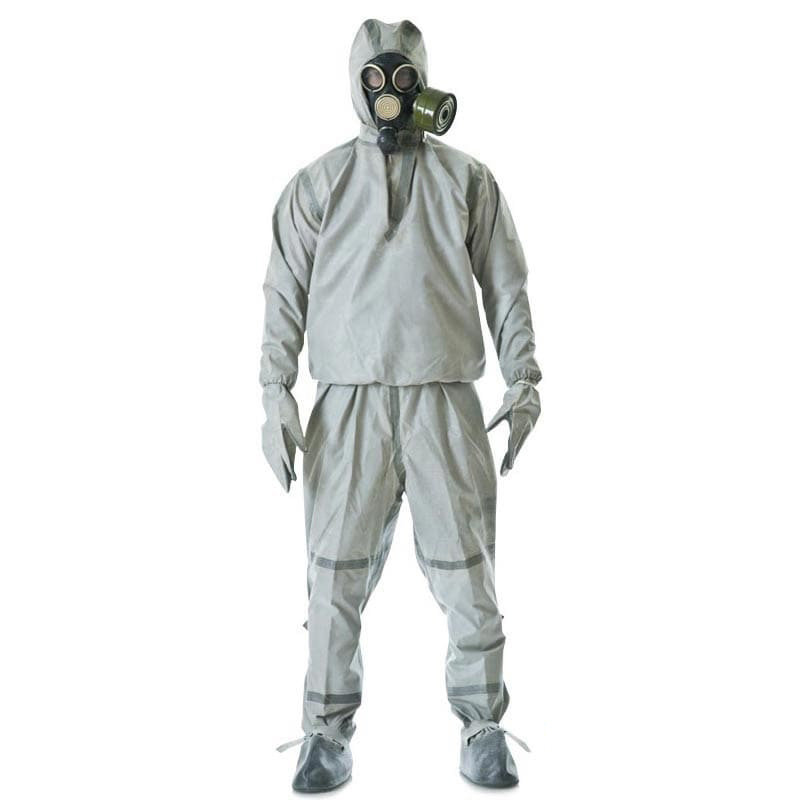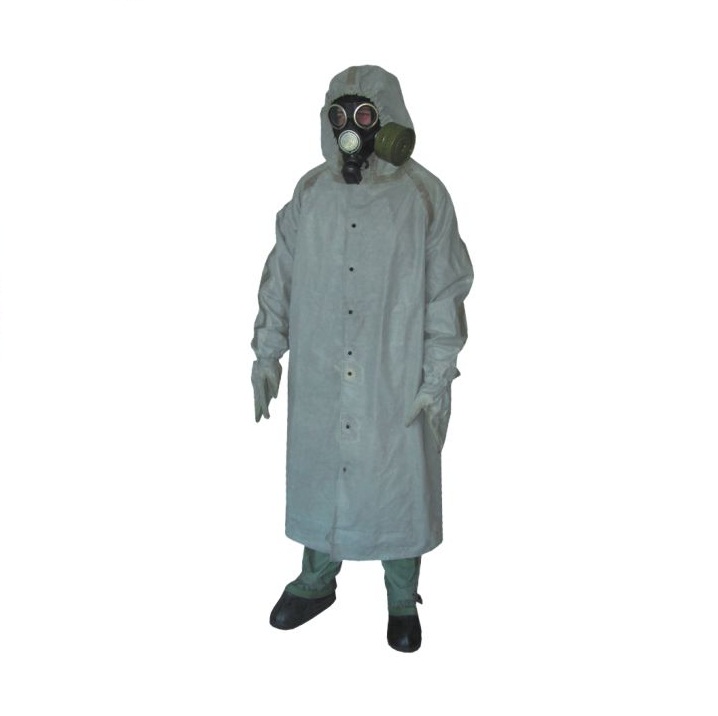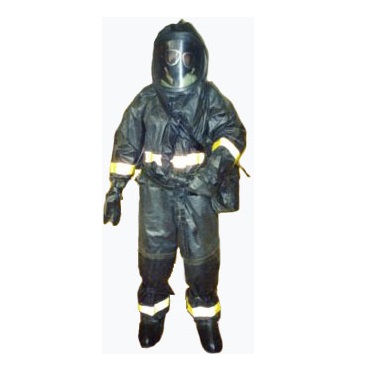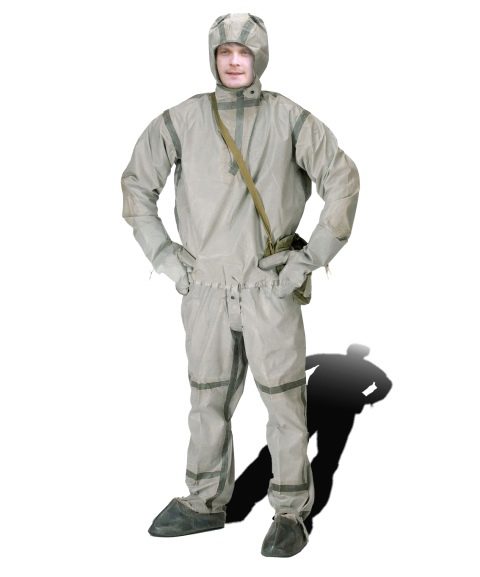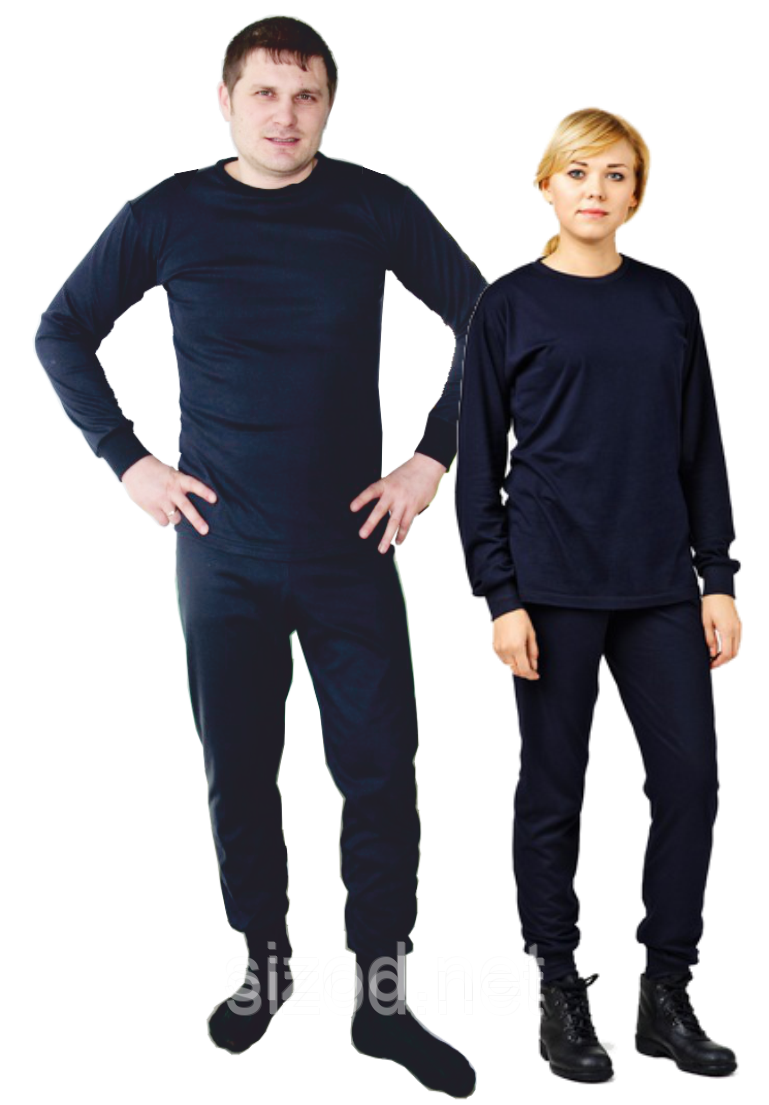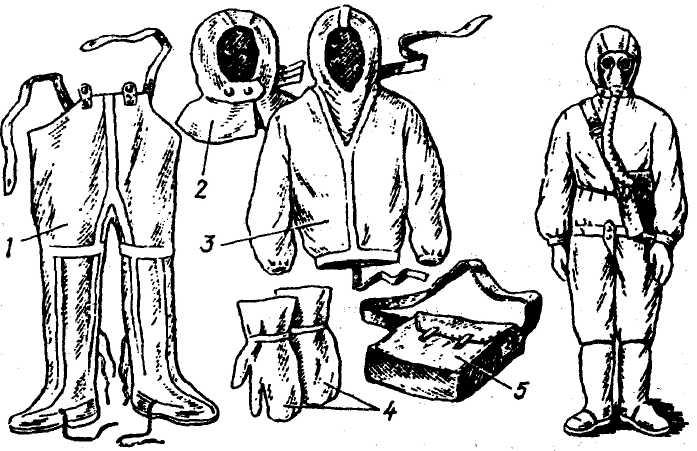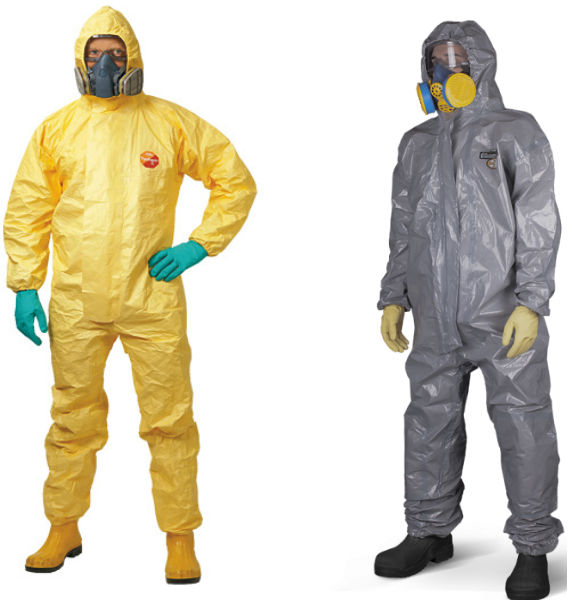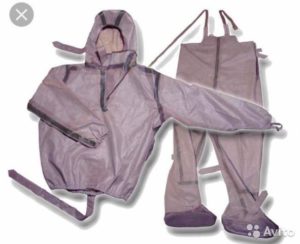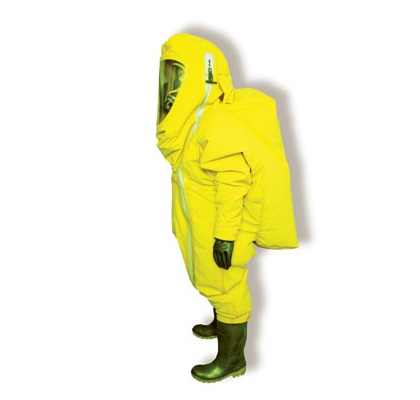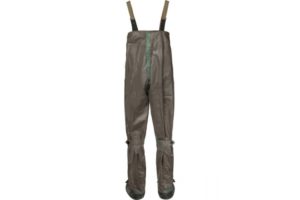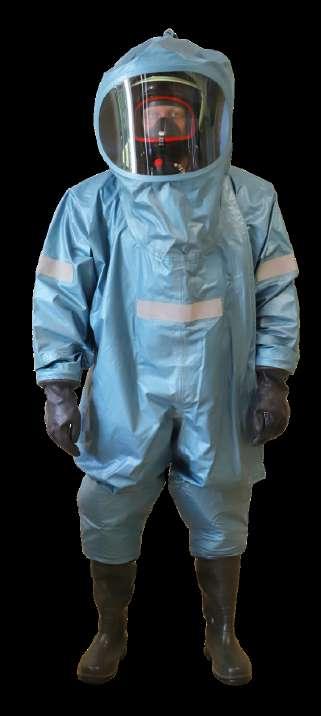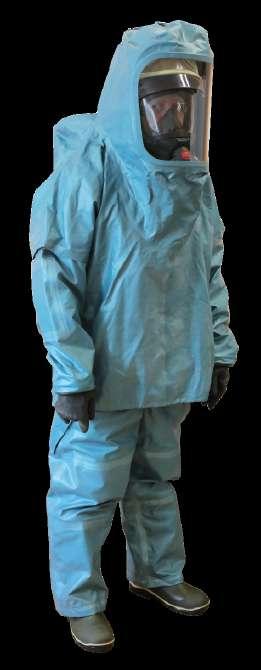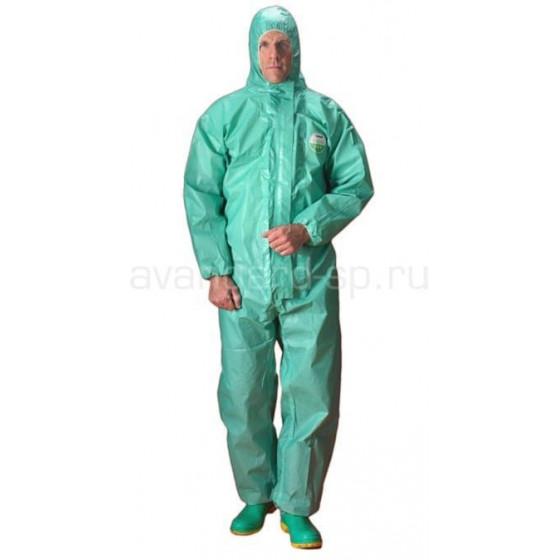Features and purpose
The lightweight and moisture-proof set of the L-1 series belongs to the means of skin protection and is designed for the so-called intermittent wear. Such suits are used in areas contaminated with various harmful substances, including poisonous ones. Taking into account the technical characteristics, they are used at chemical industry enterprises and in the implementation of measures of varying complexity, within the framework of which degassing and disinfection are carried out.

Comparing the described suit with the standard OZK set, it is worth focusing, first of all, on the ease and ease of use of the first one. It should be noted that for all its advantages, it is made of materials that are not heat-resistant.
It is important to take into account that the described chemical protection, with an appropriate level of contamination and correct processing, can be used repeatedly
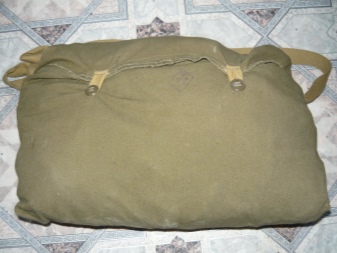
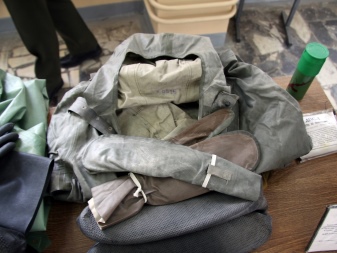
The described means of protection is most often used in combination with a gas mask. The operating instructions deserve special attention in such situations.
It is also important to take into account the properties of toxic and chemical substances and the level of contamination (pollution) of the area. The use of kits is strictly prohibited if the exact composition of the aggressive environment is not known.

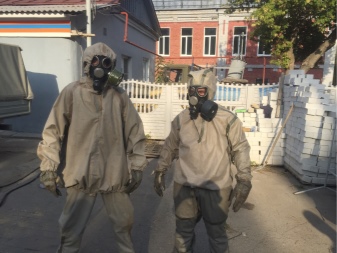
Analyzing the features of the suits under consideration, the following important points should be noted:
- long-term wearing is quite problematic due to tight fit and poor ventilation;
- L-1 is of little use for other purposes (for example, when used as a raincoat, the jacket will be short);
- operating temperature range - from -40 to +40 degrees;
- set weight - from 3.3 to 3.7 kg;
- all seams are qualitatively sealed with a special tape.
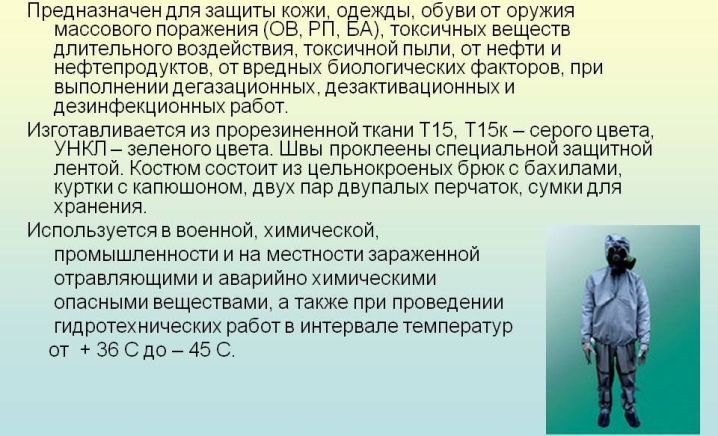
The main characteristics of the suit
Such suits are sewn with inserts from special fabrics capable of reflecting the light falling on them. The fabric from which the men's jacket, trousers and overalls are sewn is resistant to various types of dirt, protects from the wind and is impregnated with a composition that does not allow the kit to get wet. Reflective elements perform their function equally well in all weather conditions.
On the set of class 3 there are strips 5 cm wide, they are located both on the belt and along the length of the entire person's height. In addition, additional reflective stripes are located throughout the suit, which can provide the highest safety and quality of protection.
Suit complete set
The suit consists of a jacket and trousers, in some cases only vests are used. In the winter season, most often, preference is given to a jacket and semi-overalls. It is desirable that the robes be equipped with pockets with a flap, this will provide greater convenience. Winter and summer options are distinguished by the presence of insulation and the composition of the fabric.
For the warm season, coarse calico kits are best suited, they absorb moisture well, allow air to pass through, and also do not fade or fade. The material called "diagonal" will give additional strength to the kit, and nylon is most often used in winter versions.
Material
If a reflective suit is purchased for use in winter, it must have insulating linings, a hood, a jacket with a zipper, and sleeves with cotton cuffs. In addition, water-repellent materials are used to protect the worker from cold wind, rain and snow.
In the summer, natural breathable fabrics are used to help the employee feel better in the heat.
Important! Natural fabrics get dirty faster than synthetic fabrics.Reflective detailing on both trousers and jackets
Thanks to them, you can recognize a human silhouette in the dark.
Reflective elements are found on both trousers and jackets. Thanks to them, you can recognize a human silhouette in the dark.
Signal elements
A signal class 3 suit is sewn with a large number of reflective stripes, they are located on the belt, legs, sleeves and in the shoulder area. The color of the background material is most often made bright as well, but blue or black can be used. If the sewn-in reflective stripes are made of high quality materials, then the basis of the suit can be any and does not really matter.
Such sets are designed for long-term use, special care is not required for them, it is enough to wash, taking into account the main type of fabric.
Putting on and taking off
According to the current rules of the mechanism for the use of LZK, there are 3 of its provisions, namely marching, ready and directly combat. The first option provides for the transportation of the set in the stacked state. In the second case, as a rule, we are talking about the use of a kit without respiratory protection. The transfer to the working state, that is, the third, from the indicated positions is carried out after the corresponding command. In this case, the rules provide for the following algorithm of actions:
- take off all equipment, including headgear, if any;
- remove the kit from the bag, fully straighten it and place it on the ground;
- put on the lower part of L-1, fixing all the straps with "mushrooms";
- throw the straps crosswise over both shoulders, and then fasten them to the stockings;
- put on a jacket, throwing its hood back and fasten the crotch strap;
- put on and fasten the equipment, if any;
- put on a gas mask bag;
- place the previously removed headdress in the L-1 carrying bag and put it on;
- put on a gas mask and a hood over it;
- carefully straighten all the folds on the jacket;
- wrap the neck strap tightly but neatly around the neck and fix it with a fastener in the form of a fungus;
- put on a protective helmet, if one is included in the equipment set;
- put on gloves so that the elastic bands tightly wrapped around the wrists;
- hook on the special elastic bands of the sleeves of the L-1 suit on the thumbs.

Take off the suit outside the contaminated area.
If, after removal, it is required to reapply the kit, which has been exposed to harmful substances, without treatment, then the following steps must be performed:
remove the top;
carefully remove contaminated gloves;
lower the straps without unfastening them;
holding the straps, as well as the stockings themselves, remove them with the utmost care;
wrap the straps themselves and the clean surface of the stockings inside;
place trousers near the stacked upper part of the set;
put on gloves, taking only the inside and clean part of the leggings;
make tight rolls from both parts of the kit and place them evenly in the carrier;
fix the valves with a special tape and perform a thorough surface treatment;
take off gloves, trying to avoid touching the outer surface, and place them on the tightened valves;
close the lid tightly and fasten both buttons.
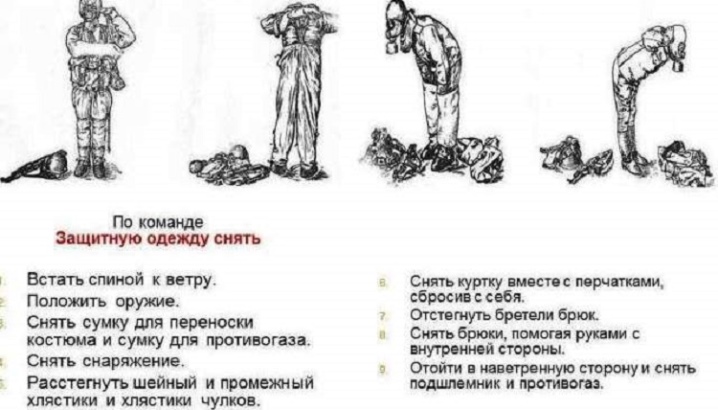
After all the steps described above are completed, the bag should be placed where the risk of inhalation of harmful substances and their vapors on people will be minimized. Then it remains to carefully process your hands.

Pros and cons of beige
Men's beige "two-piece" has a number of undeniable advantages: it is easy to choose a shirt for it, it suits men of any age and looks good both in winter and summer outfits.
A light beige suit will set off a tan, and a set in a dark beige tone will make the image more contrasting, especially if you put on a shirt of a different color from the suit.The product, precisely matched to the figure, will make the image elegant and attractive, despite the absence of bright accents and decor. This is the peculiarity of the beige color - it looks practical and utilitarian, but creates a festive mood.
In a beige suit, you can safely go to the carpet, not that to a graduation or a gala event. The men's beige "deuce" will not fail at a significant event. Those who like stricter options will find for themselves a spectacular "three" with a fitted jacket and a cropped vest with buttons.
There are many shades of beige. Cold tones will help out the owner of fair skin. They will emphasize the noble pallor and create a strict and discreet bow. By the way, cold beige has a slimming effect, but warm tones look more playful and inviting.
"Two" beige with a transition to peach or pink is perfect for a young man with a warm skin tone.
The product has few disadvantages. Of course, a beige suit is not as easily soiled as a white one, but caring for it will still be more difficult than for a gray or brown set.
Storage
One of the key points in the context of the proper storage of the chemical protection in question is its proper installation. After removing the suit and processing it, you must:
- make a roll out of a jacket by folding it in half lengthwise;
- perform similar actions with trousers;
- place all the elements of the kit evenly in the carrier.
Store protective equipment to prevent overheating and direct sunlight. Remove from carry bag and put on suit just before starting work
It is important to remember that the main properties and all performance indicators of the described personal protective equipment directly depend on the state of the material of its constituent parts and fasteners
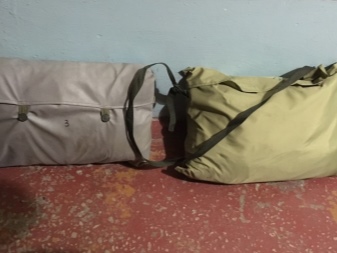

How to put on a protective suit L-1, see below.
Equipment
The delivery set of lightweight chemical protection consists of the following items.
- A semi-overalls equipped with zip ties, which also has reinforced stockings that are worn over shoes. In addition, the jumpsuit has cotton straps with half rings made of metal and designed to fasten the legs. In the area of the knee, as well as the ankle, there are “fungus” fasteners made of durable plastic. They provide maximum fit to the body.
- The upper part, which is a jacket with a hood, as well as neck and crotch straps (straps) and two thumb loops located at the ends of the sleeves. The latter are equipped with cuffs that fit snugly around the wrists. For high-quality fixation of the hood, there is a strap with a fastener in the form of a "fungus". At low temperatures, it is recommended to wear a comforter under the hood.
- Two-fingered gloves made of UNKL or T-15 fabric. They are fixed on the hands with the help of special elastic bands.
OZK standards in the army
Trainees in the subdivision are in the ranks or perform work on the serviced equipment, etc. Gas masks and respirators in the "stowed" position. command is issued unexpectedly"GASES" or "RESPIRATOR TO PUT ON" ... Trainees wear gas masks or respirators. Assessment of the standard number 1:
| Soldiers, sergeants, warrant officers, officers | ||
| Great | OK | satisfactorily |
| 7 s | 8 s | 10 s |
| Calculation, department | ||
| Great | OK | satisfactorily |
| 8 s | 9 s | 11 s |
| Platoon | ||
| Great | OK | satisfactorily |
| 9 s | 10 s | 12 s |
| Company | ||
| Great | OK | satisfactorily |
| 10 s | 11 s | 13 s |
ERRORS REDUCING THE ESTIMATE BY ONE POINT.
- when putting on a gas mask, the trainee did not close his eyes and did not hold his breath or, after putting on, did not exhale completely
- helmet - the mask is worn skewed or the connecting tube is twisted.
- the ends of the respirator nose clip are not pressed against the nose.
ERRORS DEFINING THE ASSESSMENT "UNSATISFACTORY"
- the formation of such folds or distortions is allowed, in which the outside air can penetrate under the helmet - mask.
- the tightness of the connection of the gas mask box with the front part is not ensured.
Regulation No. 3A: Putting on a combined-arms protective kit in the form of a raincoat and a gas mask
Servicemen perform a combat mission, protective equipment for trainees.
At the command: “CLOTH IN THE SLEEVES, STOCKINGS, GLOVES TO PUT ON. GASES ”servicemen put on OZK in the form of raincoats and gas masks. Assessment of the standard No. 3a:
| Soldiers, sergeants, warrant officers, officers | ||
| Great | OK | satisfactorily |
| 3 min | 3 min 20 s | 4 minutes |
| Subdivision | ||
| Great | OK | satisfactorily |
| 4 minutes | 4 min 20 s | 5 min 10 s |
ERRORS REDUCING THE ESTIMATE BY ONE POINT.
- putting on stockings with fastened straps.
- the sides of the raincoat are not properly fastened.
- the pin holders are not fastened or two pins are not fastened.
- not worn over protection equipment.
- the straps are not attached to the belt.
ERRORS DEFINING THE ASSESSMENT "UNSATISFACTORY"
- the formation of such folds or distortions is allowed, in which the outside air can penetrate under the helmet - mask.
- the tightness of the connection of the gas mask box with the front part is not ensured.
Norm No. 3B: Putting on a combined-arms protective kit in the form of an overalls
Servicemen perform a combat mission, protective equipment for trainees. At the command: “WEAR PROTECTIVE KIT. GASES ”servicemen put on OZK in the form of overalls. Assessment of the standard No. 3b:
| Soldiers, sergeants, warrant officers, officers | ||
| Great | OK | satisfactorily |
| 4 min 35 s | 5 minutes | 6 minutes |
| Subdivision | ||
| Great | OK | satisfactorily |
| 4 min 50 s | 5 min 20 s | 6 min 20 s |
ERRORS REDUCING THE SCORE BY ONE POINT
- when putting on a gas mask, the trainee did not close his eyes and did not hold his breath or, after putting on, did not exhale completely
- helmet - the mask is worn skewed or the connecting tube is twisted
- the ends of the nose clip of the respirator are not pressed against the nose
- putting on stockings with fastened straps
- the sides of the raincoat are not fastened correctly
- the pin holders are not fastened or two pins are not fastened
- not worn over protection equipment
- the straps are not attached to the belt
ERRORS DEFINING THE ASSESSMENT "UNSATISFACTORY"
- the formation of such folds or distortions is allowed, in which the outside air can penetrate under the helmet - mask
- the tightness of the connection of the gas mask box with the front part is not ensured
Regulation No. 10: Actions on the outbreak of a nuclear explosion
Trainees as part of a subunit perform a combat mission in an open area, are in open vehicles or outside vehicles.
An outbreak of a nuclear explosion is simulated or the command is given:"Flash on the right (left)" etc .
By a flash or command, the trainees lie on the ground (at the bottom of the car body), and if there are natural shelters or shelters 2-3 steps away, they occupy them. Estimated by time in seconds: Assessment of the standard number 10:
| Soldiers, sergeants, warrant officers, officers | ||
| Great | OK | satisfactorily |
| 2 sec | 3 sec | 4 sec |
| Crew, squad, platoon | ||
| Great | OK | satisfactorily |
| 3 sec | 4 sec | 5 sec |
| Company | ||
| Great | OK | satisfactorily |
| 4 sec | 5 sec | 6 sec |
When driving in standard vehicles, the driver stops the car, puts it on the brake, turns off the engine, closes the blinds and hatches, and bends down below the windshield. After the conditional passage of the shock wave, the trainees act on the command of the leader. Estimated by time in seconds:
| Crew, squad, platoon | ||
| Great | OK | satisfactorily |
| 7 sec | 8 sec | 10 sec |
| Company | ||
| Great | OK | satisfactorily |
| 9 sec | 10 sec | 12 sec |
ERRORS REDUCING THE SCORE BY ONE POINT
1. The protective properties of the terrain, engineering structures and equipment were not used.
2. The hands are not hidden under oneself or the collar of the overcoat is not raised.
Terms of use, service life
After applying LZK in conditions of contamination with harmful substances, regardless of the degree of aggressiveness of the environment, it must be subject to special treatment without fail. This allows the L-1 sets to be operated many times.The duration of the protective action, that is, the shelf life of the chemical protection, is directly determined by the operating conditions. An equally important point will be the methods of the aforementioned processing of sets. So, the maximum period of validity of chemical protection, taking into account OV and hazardous chemicals, is:
- chlorine, hydrogen sulfide, ammonia and hydrogen chloride in a gaseous state, as well as acetone and methanol - 4 hours;
- sodium hydroxide, acetonitrile and ethyl acetate - 2 hours;
- heptyl, amyl, toluene, hydrazine and triethylamine - 1 hour;
- toxic substances in the form of steam and drops - 8 hours and 40 minutes, respectively.
According to the current GOST, a lightweight suit is able to provide effective protection against acids with a concentration of up to 80% in terms of H2SO4, as well as alkalis with a concentration exceeding 50% in terms of NAOH.
In addition to everything already mentioned, a light suit should have the following properties:
- acid resistance - from 10%;
- acid resistance for at least 4 hours;
- resistance to direct action of acids and open fire - up to 1 hour and 4 seconds, respectively;
- tensile load that the seams must withstand - from 200 N.
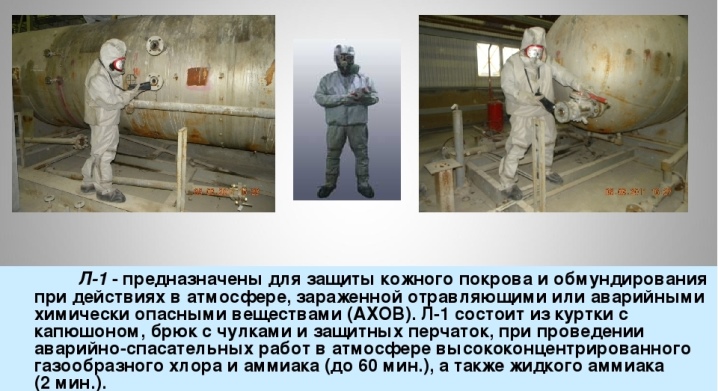
Selection Tips
When choosing personal protective equipment, you need to pay special attention to 3 key points. First of all, we are talking about a supplier of lightweight chemical protection kits
It is highly recommended to give preference to the manufacturers themselves. If it is not possible to order directly, it is worth contacting stores with an appropriate reputation. As a rule, trusted suppliers try to avoid image risks
First of all, we are talking about a supplier of lightweight chemical protection kits. It is highly recommended to give preference to the manufacturers themselves. If it is not possible to order directly, it is worth contacting stores with an appropriate reputation. As a rule, trusted suppliers try to avoid image risks.
The second whale on which the correct choice of LZK stands is the availability of documents drawn up at the manufacturing plant.
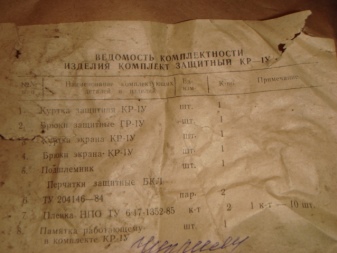
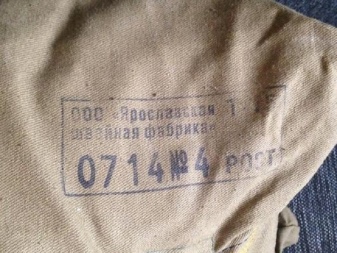
In addition to all of the above, do not forget about such an important point as a careful personal check of all elements of the kit
During the inspection, special attention should be paid to the completeness, integrity and condition of the fasteners.
